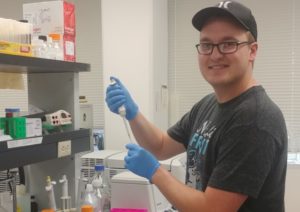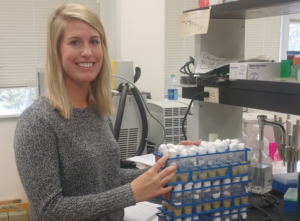My research interests are in the evolutionary genetics of host/pathogen interactions. I am particularly interested in understanding how pathogen genetics and virulence change following host shifts to permit a successful long term infection of the novel host.
My lab studies host/pathogens interactions. We use Drosophila and Drosophila-specific viruses in a model system to learn about the evolution of virulence (harm to host) following host shifts by studying the genetics of the pathogen and pathogenesis in the host. We want to understand why pathogens are capable of moving across host species (e.g. pigs to humans in swine flu).
Students interested in undergraduate or graduate research experiences should contact me by email to set up an appointment to meet and discuss current opportunities in the lab.
| Graduate Students | Projects |
|---|---|
 | Taylor Mauzy Taylor is currently working to develop a food-grade probiotic system that will allow for the in-situ expression of therapeutic enzymes in the host gut. He is testing whether this is a feasible approach for enzyme delivery using Lacotcocus lactis and a custom-designed vector. |
 | Katie Johnson Katie is currently working on testing some long-standing generalities concerning the evolution of virulence using the Drosophila model and the highly pathogenic Drosophila C virus. Evolutionary theory based on serial passage experiments using bacteria and bacteriophages suggests that virulence will increase on the novel host after a host shift, that the pathogen will experience convergent evolution, and that the pathogen will become attenuated to the native host. Katie is testing whether these generalities still hold for a complex host with a highly virulent pathogen. |
 | Steven A. Smith Thesis Title: Identification of genes from the poxvirus of a parasitoid wasp Thesis Abstract: The Diachasmimorpha longicaudata entomopoxvirus (DlEPV) is a presently unclassified, insect-specific poxvirus. The virus was first identified in the accessory poison gland apparatus of a female parasitoid wasp, D. longicaudata. The wasp apparently injects DlEPV into host fly larvae along with the egg during oviposition. Although the effect of the presence of DlEPV on wasp larvae survival within the host is unknown, the virus does appear to disrupt haemocyte encapsulation response. The DlEPV genome has not yet been fully characterized. A total of nineteen genes have been identified (10 of known functions, 9 of unknown) and the expected genome size is 290—300 kilobase pairs (kbp). We subjected DlEPV DNA to sequencing and structural analysis. We found all 19 known DlEPV genes, identified an additional 48 DlEPV genes; thus more than doubling the number of know DlEPV genes. DlEPV open reading frames (ORFs) were found to have significant homology to both essential and nonessential poxvirus genes. We also report the presence of a putative NAD+-dependent DNA ligase, only the second example of this gene from a virus. DlEPV clearly is a poxvirus. However, it likely needs to be classified into its own genus as it is quite different to other EPVs. Link to full thesis |
 | Emily K. Hendrix Thesis Title: Characterizing the early stages of a novel host shift using host fitness and metabolomics Thesis Abstract: The factors that contribute to successful colonization of a novel host species by a pathogen remain unclear. One likely factor determining host shift success is the early interaction between host and pathogen at the very moment of the host shift event. How does a novel host respond to a pathogen insult immediately following infection? To answer this question, the Drosophila model was used along with the highly pathogenic Drosophila C virus, host fitness assays and metabolomic analysis to measure the host’s response to a novel pathogenic infection. As Wolbachia can interfere with RNA virus infection success, a new method was developed to reliably and quickly eliminate Wolbachia from the flies. Once the flied were confirmed to be Wolbachia-free, they were injected with DCV. Females of the native host (D. melanogaster) and the novel host (D. mauritiana) were injected with DCV or Schneider’s media, subjected to fitness tests, frozen in liquid nitrogen and their metabolomes were analyzed. The novel host had equal or increased fitness (fecundity, hatchability, pupation, number of pupae, and number of adults), but significantly higher mortality. Metabolomic analysis revealed that many metabolites from a variety of metabolic pathways were significantly different. A wide range of stress-related metabolites were upregulated in the native host, but not in the novel host. These results support the hypothesis that the initial physiological interaction between a pathogen and its novel host is critical for the survival of the host or the success of the pathogen. Link to full thesis |

